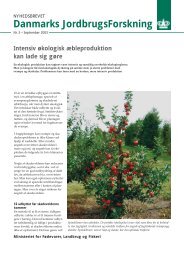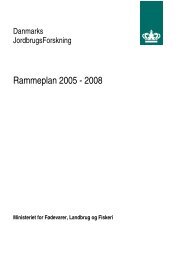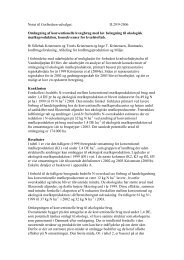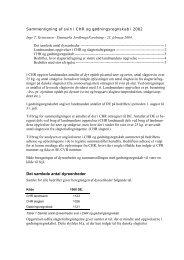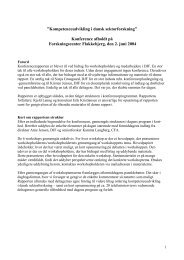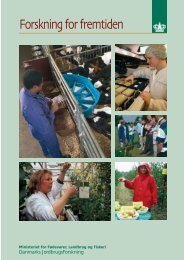Reproduction performances and conditions of group-housed non ...
Reproduction performances and conditions of group-housed non ...
Reproduction performances and conditions of group-housed non ...
Create successful ePaper yourself
Turn your PDF publications into a flip-book with our unique Google optimized e-Paper software.
- Paper I -<br />
However, this does not seem to be a possible explanation for the conflicting results in the<br />
mentioned studies given in Table 2.<br />
Anderson (1975) studied the effect <strong>of</strong> total starvation from ten days before mating to respectively<br />
14, 18, 22, 26, 30 <strong>and</strong> 34 days after mating <strong>and</strong> found no differences in embryo<br />
survival rate in the sows that remained pregnant compared to control animals given a full<br />
diet (2.7 kg). The number <strong>of</strong> embryos was lower in the starved sows but this was because <strong>of</strong><br />
a lower ovulation rate <strong>and</strong> therefore probably founded before mating.<br />
The effect <strong>of</strong> energy intake in early pregnancy on pregnancy rate has not been subject for<br />
much research. Dyck & Strain (1983) found that the <strong>group</strong> with low energy supply (17.6<br />
MJ ME day -1 ) in the entire period from mating to 30/35 days after mating had lower pregnancy<br />
rate (64.3%) than the other <strong>group</strong>s (86.2-87.1%). This was not the case for sows with<br />
low energy supply only in the first ten days <strong>of</strong> pregnancy. The conception failure occurred<br />
after day ten <strong>and</strong> before day 30 <strong>and</strong> the authors therefore hypothesized that the conception<br />
failure was due to failure <strong>of</strong> either early embryonic growth or implantation.<br />
It has not been possible to find more recent references about the effect <strong>of</strong> energy intake in<br />
early pregnancy on conception rate. However, Anderson (1975) investigated the effect <strong>of</strong><br />
total inanition in gilts from ten days before mating until 14, 18, 22, 26, 30 <strong>and</strong> 34 days respectively<br />
after mating. They found that 22 <strong>of</strong> 36 gilts (61 %) remained pregnant. Of these<br />
gilts, six out <strong>of</strong> six (100 %) remained pregnant after day 14 after mating whereas 13 out <strong>of</strong><br />
18 (72 %) remained pregnant when inanition continued to day 18, 22 <strong>and</strong> 26 after mating<br />
<strong>and</strong> inanition longer than that resulted in a pregnancy rate <strong>of</strong> 25 % (three <strong>of</strong> 12 gilts).<br />
In summary, there are indications that moderate (31.3 MJ ME day -1 ) compared to low<br />
(17.6-22.8 MJ ME day -1 ) energy supply in the first three days after mating can influence<br />
embryo survival negatively in gilts. However, the results are conflicting. The effect <strong>of</strong> very<br />
low feed intake in early pregnancy in gilts has almost not been studied, but one study did<br />
not find a negative effect <strong>of</strong> total starvation compared to moderate feed intake in early<br />
pregnancy (34 days) on embryo survival rate in the sows that remained pregnant. Regarding<br />
pregnancy rate, it seems that low energy intake (17.6 MJ ME day -1 or less) compared to<br />
moderate energy supply (29.4 MJ ME day -1 , 2.7 kg) the first 30/35 days in pregnancy may<br />
have a negative effect.<br />
Sows<br />
High energy supply (50.1, 38.4, 48.6 MJ ME day -1 ) when treatment beginning three days<br />
after mating (Toplis et al., 1983) or immediately after mating (Sørensen, 1994) does not<br />
33




